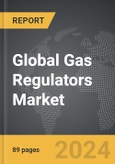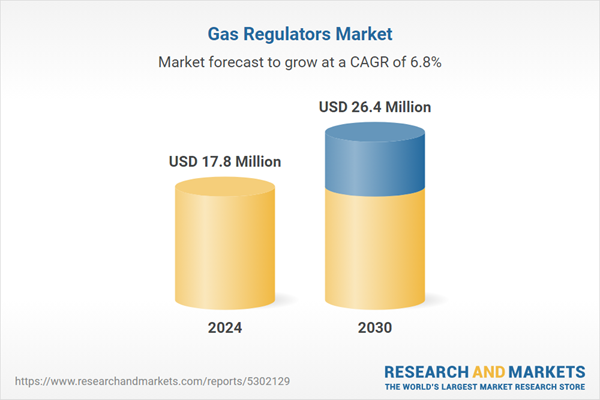The global market for Gas Regulators was valued at USD 17.8 Million in 2024 and is projected to reach USD 26.4 Million by 2030, growing at a CAGR of 6.8% from 2024 to 2030. This comprehensive report provides an in-depth analysis of market trends, drivers, and forecasts, helping you make informed business decisions.
Global Gas Regulators Market - Key Trends and Drivers Summarized
Why Are Gas Regulators Critical for Industrial and Laboratory Applications?
Gas regulators are critical components used to control and maintain the pressure and flow of gases from a pressurized source to a downstream system or device. By reducing the high pressure of a gas cylinder or pipeline to a stable, usable level, gas regulators ensure safe and consistent gas delivery for applications across a wide range of industries, including manufacturing, healthcare, research, and energy. These devices come in various configurations, such as single-stage and dual-stage regulators, each tailored for specific pressure ranges and precision requirements. Single-stage regulators reduce the gas pressure in one step and are typically used for applications where constant pressure is less critical, such as welding or heating. In contrast, dual-stage regulators adjust the pressure in two stages, providing a more stable output that is ideal for precision applications like laboratory experiments, semiconductor manufacturing, and analytical instrumentation. Gas regulators are also designed with different materials and seals to handle a variety of gases, from inert ones like nitrogen and argon to reactive or corrosive gases like hydrogen and chlorine. Given their pivotal role in maintaining operational safety and efficiency, gas regulators are engineered to comply with stringent safety standards and incorporate features such as pressure relief valves, leak detection, and tamper-proof adjustments, making them indispensable in any setting where precise gas control is required.How Are Gas Regulators Evolving to Meet the Needs of Modern Industries?
The design and functionality of gas regulators have evolved significantly to meet the increasingly sophisticated demands of modern industries, focusing on greater precision, enhanced safety, and user convenience. One of the key trends is the development of high-purity gas regulators, which are designed to handle ultra-high purity gases used in sensitive applications like semiconductor fabrication, pharmaceutical production, and chemical research. These regulators feature electropolished internal surfaces, minimal dead volume, and advanced sealing technologies to prevent contamination and ensure consistent gas quality. Another major advancement is the integration of digital technology into gas regulators, resulting in smart regulators that offer real-time monitoring and remote control capabilities. These digital regulators are equipped with sensors that measure pressure, flow, and temperature, and can transmit data to a central control system or even a mobile device, enabling precise adjustments and predictive maintenance. This smart functionality is particularly valuable in industries where continuous gas supply and tight control are crucial, such as in biopharmaceutical manufacturing or complex chemical processes. Additionally, manufacturers are focusing on the miniaturization of gas regulators to meet the space constraints of modern laboratory setups and portable devices. Compact, lightweight designs that do not sacrifice performance are becoming increasingly popular for mobile analytical instruments and portable medical equipment. Furthermore, the demand for sustainable solutions is driving the development of energy-efficient regulators that minimize gas waste and reduce the environmental impact of industrial operations.What Technological Innovations Are Defining the Future of Gas Regulators?
The future of gas regulators is being shaped by a series of technological breakthroughs that are enhancing their accuracy, reliability, and integration into automated systems. One of the most significant innovations is the adoption of smart sensing technologies, such as micro-electromechanical systems (MEMS) sensors, which enable gas regulators to monitor and adjust pressure and flow with exceptional precision. These sensors, combined with AI-driven algorithms, allow for adaptive pressure control, real-time diagnostics, and self-calibration, significantly reducing the risk of manual errors and enhancing overall system efficiency. Another key development is the rise of electronic pressure regulators, which use solenoid valves and electronic controllers to provide dynamic and highly accurate control of gas pressure. These regulators are ideal for applications that require rapid pressure changes or very fine control, such as gas chromatography or aerospace testing. The integration of wireless communication technologies is also transforming gas regulators, enabling remote monitoring and control via Wi-Fi or Bluetooth. This connectivity allows operators to adjust regulator settings from a distance, receive alerts in case of anomalies, and access historical data for trend analysis and optimization. Additionally, advancements in materials science are leading to the development of more durable and corrosion-resistant regulators, capable of handling aggressive or high-pressure gases in extreme environments, such as in deep-sea or high-altitude applications. Moreover, hybrid regulators that combine mechanical and electronic elements are emerging, offering the reliability of traditional designs with the precision and flexibility of digital systems.What Key Market Trends Are Fueling the Growth of the Gas Regulator Industry?
The growth in the gas regulator market is driven by several key factors, including the expansion of the healthcare and pharmaceutical industries, the increasing demand for precise gas control in manufacturing, and the rise of automation and digitalization across industrial sectors. One of the primary drivers is the growing use of gas regulators in medical applications, where the need for precise and safe control of oxygen, anesthetic gases, and other medical gases is critical. The global response to health emergencies has led to a surge in demand for oxygen regulators and other medical gas equipment to support respiratory treatments and intensive care units. Another significant driver is the semiconductor and electronics manufacturing industry, which requires ultra-high purity gases and highly precise regulation for processes such as chemical vapor deposition (CVD) and photolithography. The push for smaller and more powerful electronic devices is fueling investments in advanced gas regulators that can maintain the strict purity and pressure requirements of these production environments. Additionally, the trend towards Industry 4.0 and the adoption of smart manufacturing practices are supporting market growth, as industries seek to implement gas regulators that offer enhanced connectivity, real-time data monitoring, and integration with automated control systems. The emphasis on safety and compliance with stringent regulations in industries like oil and gas, chemicals, and food processing is also driving the adoption of advanced gas regulators that feature robust safety mechanisms and precise control capabilities. With these factors converging, the gas regulator market is poised for strong growth, supported by technological innovations and the expanding application of high-precision gas control solutions in diverse industrial and commercial settings.Report Scope
The report analyzes the Gas Regulators market, presented in terms of market value (USD Thousand). The analysis covers the key segments and geographic regions outlined below.Segments
Segment (Gas Regulators).Geographic Regions/Countries
World; United States; Canada; Japan; China; Europe (France; Germany; Italy; United Kingdom; Spain; Russia; and Rest of Europe); Asia-Pacific (Australia; India; South Korea; and Rest of Asia-Pacific); Latin America (Argentina; Brazil; Mexico; and Rest of Latin America); Middle East (Iran; Israel; Saudi Arabia; United Arab Emirates; and Rest of Middle East); and Africa.Regional Analysis
Gain insights into the U.S. market, valued at $4.6 Million in 2024, and China, forecasted to grow at an impressive 10.4% CAGR to reach $6.4 Million by 2030. Discover growth trends in other key regions, including Japan, Canada, Germany, and the Asia-Pacific.Report Features:
- Comprehensive Market Data: Independent analysis of annual sales and market forecasts in USD from 2024 to 2030.
- In-Depth Regional Analysis: Detailed insights into key markets, including the U.S., China, Japan, Canada, Europe, Asia-Pacific, Latin America, Middle East, and Africa.
- Company Profiles: Coverage of major players such as Air Liquide, Air Products and Chemicals Inc., Airgas Inc., Cavagna Group SPA, Colfax Corporation and more.
- Complimentary Updates: Receive free report updates for one year to keep you informed of the latest market developments.
Why You Should Buy This Report:
- Detailed Market Analysis: Access a thorough analysis of the Global Gas Regulators Market, covering all major geographic regions and market segments.
- Competitive Insights: Get an overview of the competitive landscape, including the market presence of major players across different geographies.
- Future Trends and Drivers: Understand the key trends and drivers shaping the future of the Global Gas Regulators Market.
- Actionable Insights: Benefit from actionable insights that can help you identify new revenue opportunities and make strategic business decisions.
Key Questions Answered:
- How is the Global Gas Regulators Market expected to evolve by 2030?
- What are the main drivers and restraints affecting the market?
- Which market segments will grow the most over the forecast period?
- How will market shares for different regions and segments change by 2030?
- Who are the leading players in the market, and what are their prospects?
Some of the 34 major companies featured in this Gas Regulators market report include:
- Air Liquide
- Air Products and Chemicals Inc.
- Airgas Inc.
- Cavagna Group SPA
- Colfax Corporation
- Emerson Electric Co.
- GCE Group
- Itron
- Praxair Inc.
- The Linde Group
Table of Contents
I. METHODOLOGYII. EXECUTIVE SUMMARY2. FOCUS ON SELECT PLAYERSIII. MARKET ANALYSISIV. COMPETITION
1. MARKET OVERVIEW
3. MARKET TRENDS & DRIVERS
4. GLOBAL MARKET PERSPECTIVE
UNITED STATES
CANADA
JAPAN
CHINA
EUROPE
FRANCE
GERMANY
ITALY
UNITED KINGDOM
SPAIN
RUSSIA
REST OF EUROPE
ASIA-PACIFIC
AUSTRALIA
INDIA
SOUTH KOREA
REST OF ASIA-PACIFIC
LATIN AMERICA
ARGENTINA
BRAZIL
MEXICO
REST OF LATIN AMERICA
MIDDLE EAST
IRAN
ISRAEL
SAUDI ARABIA
UNITED ARAB EMIRATES
REST OF MIDDLE EAST
AFRICA
Companies Mentioned (Partial List)
A selection of companies mentioned in this report includes, but is not limited to:
- Air Liquide
- Air Products and Chemicals Inc.
- Airgas Inc.
- Cavagna Group SPA
- Colfax Corporation
- Emerson Electric Co.
- GCE Group
- Itron
- Praxair Inc.
- The Linde Group
Table Information
| Report Attribute | Details |
|---|---|
| No. of Pages | 89 |
| Published | April 2025 |
| Forecast Period | 2024 - 2030 |
| Estimated Market Value ( USD | $ 17.8 Million |
| Forecasted Market Value ( USD | $ 26.4 Million |
| Compound Annual Growth Rate | 6.8% |
| Regions Covered | Global |









